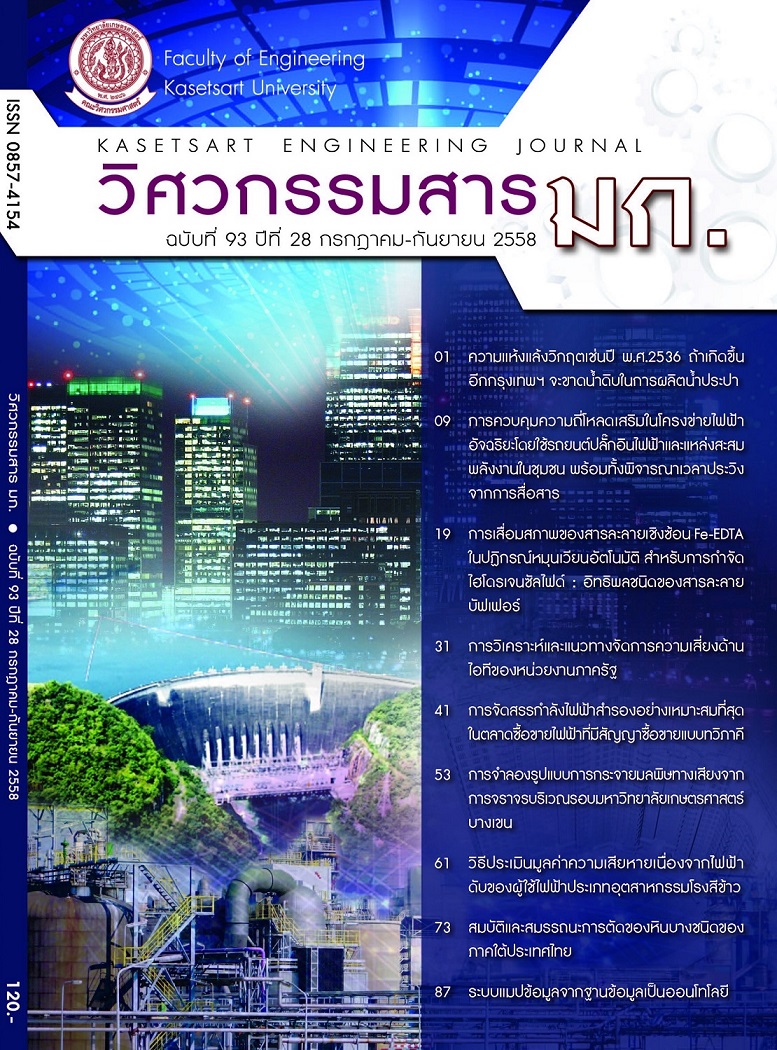การจำลองรูปแบบการกระจายมลพิษทางเสียงจากการจราจรบริเวณรอบมหาวิทยาลัยเกษตรศาสตร์ บางเขน
Keywords:
เสียงจากการจราจร, การจำลองเสียง, มลพิษทางเสียง, roadtraffic noise, noise simulation, noise pollutionAbstract
บทความนี้มีวัตถุประสงค์หลักเพื่อประเมินปัญหามลพิษทางเสียงจากการจราจรรอบมหาวิทยาลัยเกษตรศาสตร์ โดยการใช้โปรแกรม SoundPLAN จำลองการกระจายของเสียง โดยแบ่งการจำลองเป็น 2 กรณี คือ กรณีที่ 1 จำลองการกระจายของเสียงรอบมหาวิทยาลัยเกษตรศาสตร์ แนวเขตรั้วติดกับถนนสายหลักได้แก่ ถนนพหลโยธิน ถนนงามวงศ์วาน ถนนวิภาวดีรังสิต และทางยกระดับอุตราภิมุข โดยมีเสียงรบกวนจากการจราจรเป็นแหล่งกำเนิดเสียงที่สำคัญ พบว่า ค่าความดังเสียง Leq 24 ชั่วโมง เท่ากับ 43.2- 76.3 เดซิเบลเอ โดยส่วนใหญ่มีค่าไม่เกินค่ามาตรฐานตามประกาศคณะกรรมการสิ่งแวดล้อมแห่งชาติฉบับที่ 15 พ.ศ. 2540 (ไม่เกิน 70 เดซิเบลเอ) คิดเป็นร้อยละ 87 เมื่อนำระดับเสียงกลางวันถึงกลางคืน Ldn นำมาเปรียบเทียบกับ US.EPA พบว่าระดับเสียงเท่ากับ 47.8-78 เดซิเบลเอ โดยส่วนใหญ่เกินค่าเสนอแนะของ US.EPA (ไม่เกิน 55 เดซิเบลเอ) คิดเป็นร้อยละ 72 ของพื้นที่ที่ทำการประเมินทั้งหมด ส่วนผลกระทบของมลพิษทางเสียงที่มีต่อมหาวิทยาลัยส่วนใหญ่ ได้แก่ เสียงรบกวน ทำให้หงุดหงิด รบกวนการทำงาน และเกิดความเครียด ซึ่งจะเกิดขึ้นในช่วงเวลาสั้นๆที่เกิดเสียงรบกวน ส่วนกรณีที่ 2 จำลองการกระจายของเสียงรอบมหาวิทยาลัยเกษตรศาสตร์ หลังมีการปรับปรุงสภาพตามแนวทางผ่านของเสียง โดยการสร้างกำแพงกันเสียงริมทางหลวง โดยจำลองที่ความสูง 6 เมตร พบว่าค่าความดังเสียงที่ได้ลดลงจากเดิม 0.1-15.1 เดซิเบลเอ
Noise Simulation on SoundPLAN Surrounding Kasetsart University
The purpose of this article is to study and evaluate the problems of noise pollution from the traffic in Kasetsart University area by using SoundPLAN Software application. It was separated into 2 cases. The first case was to simulate noise distribution around the area outside university boundary which are Phahonyothin Road, Ngam Wong Wan Road, ViphavadhiRangsit Road, and Utraphimuk Toll Way. Noise pollution in this area was caused by road traffic noise. The simulation showed that 24 hours Leq (Equivalent continuous sound level) in this area was 43.2 – 76.3 db(A) which did not exceed the limit of Office of National Environmental Board at 70 db(A). The simulated 24 hours Leq was about 87% of the law limit. When compare the simulated 47.8 – 78 db(A) day and night sound level or Ldn (Day-Night Average Sound Levels) with US.EPA (United States Environmental Protection Agency) which has the higher limit at 55 db(A), it is found that the sound level is mostly around 72% exceed this limit. These higher sound levels will effect to people in the area by creating an annoyance, reducing the work or learn performance and somehow will building up the mind stress to the people when this sound occurs. The second case was to simulate noise distribution around the area outside university after improved path of sound by barrier building 6 meter at height shows that sound level decrease 0.1-15 db(A).


